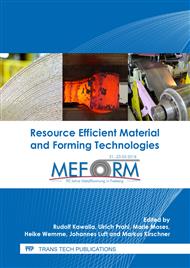p.48
p.54
p.65
p.71
p.77
p.85
p.95
p.103
p.110
Closing of Shrinkage Cavities by Means of Open-Die Forging
Abstract:
Inner cavities in cast ingots have to be closed by means of open-die forging to guarantee the integrity of the forged components during usage. In the paper a differentiation is made between the macroscopic and the microscopic closing of natural inner cavities. Special attention is paid to the dendritic structure of the surfaces of inner cavities and their impact on the microscopic closing behavior. Additionally, investigation showed that a closing on the microscopic scale is only possible if the cavities do not come in contact to the atmosphere during hot forming. For the analysis of the cavity closing, ingots of a heat-treatable, hot-working and a cold-working steel were used. The ingots were cast, forged and the surface of the inner voids was analyzed with the help of light-microscopy, SEM and EDS for the microstructure and by using tensile tests on macroscopic scale. Also, numerical investigations were a part of the work, whereby the parameters void size, void shape and anvil-shape were varied. As a result of the numerical investigation, a so called closing function was formed. This function enables the user to calculate the necessary height-reduction for closing of inner cavities of the regarded ingot format.
Info:
Periodical:
Pages:
77-84
Citation:
Online since:
March 2018
Authors:
Keywords:
Permissions:
Share:
Citation:


